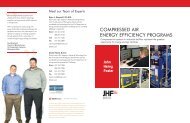The Turbo Air® 3000 Centrifugal Compressor Compressor Handbook
The Turbo Air® 3000 Centrifugal Compressor Compressor Handbook
The Turbo Air® 3000 Centrifugal Compressor Compressor Handbook
Create successful ePaper yourself
Turn your PDF publications into a flip-book with our unique Google optimized e-Paper software.
<strong>The</strong> <strong>Turbo</strong> Air <strong>3000</strong> <strong>Centrifugal</strong> <strong>Compressor</strong> Operator’s Manual<br />
Site Considerations<br />
Select the installation site and make any required preparations before compressor delivery. This will<br />
allow for a quick startup shortly after the equipment arrives. When selecting and preparing the installation<br />
site, also keep in mind that equipment located in a well planned, easily accessible area generally<br />
gets better attention from operating and maintenance personnel.<br />
<strong>The</strong> standard <strong>Turbo</strong> Air <strong>3000</strong> <strong>Compressor</strong> is designed for indoor installation. For outdoor installation, it<br />
is necessary to purchase the optional TEFC motor and NEMA-4 electrical option as part of the package.<br />
Environment<br />
A clean environment is important for optimal performance. Locate the compressor inlet air filter away<br />
from chimneys, cooling towers, steam exhausts, or any other possible sources of air contamination<br />
with foreign matter. In particular, be sure to locate the air filter at least 10 ft. (3.3 m) above ground<br />
level and at least 6 ft. (2 m) from any window, wall, or roof to further isolate it from any airborne<br />
contaminants.<br />
When selecting an outdoor installation site, consider prevailing and local ground wind patterns as well<br />
as the immediate atmospheric conditions surrounding the unit. Such factors may have long-term<br />
effects on overall compressor operation.<br />
A—6<br />
CAUTION:<br />
Select the compressor site carefully with regard to possible contamination with foreign<br />
matter. Dust, corrosive vapors, or other airborne foreign matter will adversely affect<br />
compressor performance and motor insulation life.<br />
Envelope<br />
Provide an adequate envelope (space allowance) around the unit. Figure A—1 illustrates the recommended<br />
minimum envelope in keeping with the compressor’s overall dimensions. Allow an additional<br />
3 ft. (1 m) around the sides and back of the compressor to provide adequate clearance for installation,<br />
inspection, and future maintenance. In the front, allow at least 6 ft. (2 m) for intercooler and<br />
aftercooler bundle removal.<br />
Ventilation<br />
If installing the unit in a confined area, be certain to provide adequate ventilation to dissipate heat<br />
generated by the package. <strong>The</strong> temperature immediately surrounding the compressor package<br />
should not exceed 100°F (40° C).<br />
Acoustics<br />
<strong>The</strong> mechanical processes of compressor operation will affect sound levels in the area immediately<br />
around the compressor. If the installation site is an area where hard walls and low, hard ceilings will<br />
reflect and amplify noise, it is advisable to cover the reflective surfaces with acoustical insulation.



